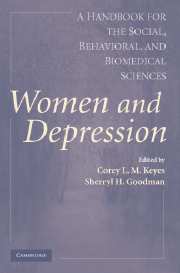Book contents
- Frontmatter
- Contents
- List of Contributors
- Foreword
- Preface
- PART I NOSOLOGY, MEASUREMENT, AND THE EPIDEMIOLOGY OF WOMEN AND DEPRESSION
- PART II BIOLOGICAL, DEVELOPMENTAL, AND AGING MODELS OF RISK
- 3 The Biological Underpinnings of Depression
- 4 Depressive Disorders in Women
- 5 Does Puberty Account for the Gender Differential in Depression?
- 6 Women's Aging and Depression
- PART III COGNITIVE, EMOTIONAL, AND INTERPERSONAL MODELS OF RISK
- PART IV SOCIAL, POLITICAL, AND ECONOMIC MODELS OF RISK
- PART V SYSTEMS AND PROCESSES OF TREATMENT, PREVENTION, AND POLICY
- Author Index
- Subject Index
- References
4 - Depressive Disorders in Women
From Menarche to beyond the Menopause
Published online by Cambridge University Press: 05 June 2012
- Frontmatter
- Contents
- List of Contributors
- Foreword
- Preface
- PART I NOSOLOGY, MEASUREMENT, AND THE EPIDEMIOLOGY OF WOMEN AND DEPRESSION
- PART II BIOLOGICAL, DEVELOPMENTAL, AND AGING MODELS OF RISK
- 3 The Biological Underpinnings of Depression
- 4 Depressive Disorders in Women
- 5 Does Puberty Account for the Gender Differential in Depression?
- 6 Women's Aging and Depression
- PART III COGNITIVE, EMOTIONAL, AND INTERPERSONAL MODELS OF RISK
- PART IV SOCIAL, POLITICAL, AND ECONOMIC MODELS OF RISK
- PART V SYSTEMS AND PROCESSES OF TREATMENT, PREVENTION, AND POLICY
- Author Index
- Subject Index
- References
Summary
INTRODUCTION
In the United States, over 30 million people experience clinical depression each year (Kessler et al., 2003), with the majority of these patients being female. The rate of depression in women is typically twice that of men, with several studies reporting variability in the lifetime ratios in different countries, for example ratios ranging from 1.6 in Beirut and Taiwan to 3.1 in West Germany (Weissman et al., 1996). The identification and treatment of depression in women has garnered increasing attention over the past decade, particularly with respect to the impact of reproductive life events on mood disorders. The National Institutes of Health has issued several announcements requesting applications to investigate this understudied area.
A major impetus for this increased research focus is that distribution of major depression across the female reproductive life cycle is variable. Women are at greatest risk for the first episode of major depression during the childbearing years (Angold, Costello, & Worthman, 1998; Bebbington et al., 1998; Weissman, 1996). The overlap between the symptoms of depression and many complaints considered by clinicians to be the normal sequelae of reproductive life events, such as menstruation, pregnancy, postpartum, and the transition to menopause, presents challenges to the accurate diagnosis as well as calls to question the validity of applying the same diagnostic criteria to women during these life events (Stowe & Newport, 1998).
- Type
- Chapter
- Information
- Women and DepressionA Handbook for the Social, Behavioral, and Biomedical Sciences, pp. 62 - 88Publisher: Cambridge University PressPrint publication year: 2006
References
- 8
- Cited by



